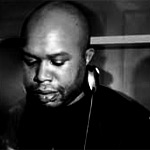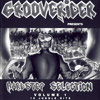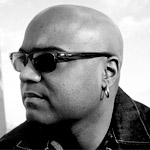Hardstep
by
Grooverider
In the beginning was the Word. In 1994 Grooverider used the word hardstep to refer to the music he was making at that time. According to an urban legend the name was suggested by Grooverider’s friend who tried to dance to his new tracks yet found it too difficult, confused by the complexity of the music. Thanks to Kickin’ Records label that was present since the times of lively British hardcore, the name was quickly assimilated into the language—that same year saw the release of the compilation Grooverider presents hardstep selection. Volume 1. (The second part was released the following year.)
Hardstep came as the next stage of ragga’s development in jungle, yet the focus was now on the music rather than on the toasting and rapping. Generally, vocal samples were used in hardstep only to complement the chaotic execution of the music, adding a special feel to it. Although the title on the compilation’s cover says that the music is a “mixture of

L Double — Retreat 1994
From Grooverider presents hardstep selection. Volume 1 compilation, Kickin’ Records
It is likely that the producers were anticipating the upcoming split of the musical scene and tried to find the opportunities for retreat realizing that the split was indeed inevitable. It is also likely that hardstep was a transitional phase between jungle and

Lemon D.
This is L.A.
Lemon D.
This is L.A.
Hardstep’s sound is in fact neither superheavy nor aggressive although the name suggests the opposite. The style’s main ingredient is the kick drum that was hardly ever used in jungle—the producers had fallen into the habit of cutting it out in the early days of the genre. That made jungle’s rhythm lighter it sounded as if it was bouncing off the ground. The second crucial component of hardstep is that the kick drum is repeatedly sampled in a complex way: not only the sample is repeated during the track, it also unexpectedly appears and repeats again for, say, 5 seconds, which makes the rhythm even more complex and difficult to dance to. Probably this is why Grooverider’s friend couldn’t quite synchronize himself to this music. All in all, the composite rhythm patter is the strongest point of hardstep.

Dream Team — Yeah man 1995
From Yeah man / Sweetie single, Joker Records

Ray Keith

Renegade — Terrorist 1994
From Terrorist / Something I feel single, Moving Shadow
Ray Keith’s famous track Terrorist that he released in 1994 under the name of Renegade is rightfully considered hardstep’s anthem. “I just stuck the break in the Akai sample, procesed it till it sounded better and then got a four-bar loop out of it,” Ray Keith tells about the creation of his hit. “A lot of people were using Amen in the early days of jungle. But Terrorist was one of the first tunes to use it clean—I took it off a breakbeat compilation, whereas a lot of people were lifting it from that Mantronix track King of the beats. Then people started liftin it off Terrorist. Now you can just drop it into Recycle of whatever and chop it into hundred pieces, but in the early days we had to chop it manually.”
Alex Reece
Pulp fiction
1995
Reese
Just want another chance
1988
Ray Keith revolutionized
Following the trend and strengthening the position of reese bassline and hardstep, DJ SS (Scratching Stein, not Schutzstaffel) released a black vinyl record that demonstrated hardstep in its full force: an astonishing mix of repetitious hats, kick drums and crash. Sentimental slow “And I will always love you” sample fuels the flame and increases the overall sassy feel. The piece is hands down the gold standard of hardstep.

DJ SS

DJ SS — Black 1995
From Black single, Formation Colours Series

Splash — Babylon (DJ Trace remix 2) 1995
Remixed by Pete Parsons, Duncan Hutchinson
From Hardstep drum ‘n’ bass. Volume 1 compilation, Desert Storm Recordings
Strange as it might seem, it is the overuse of pure amen break that soiled jungle’s sound and made hardstep solid, thick and heavy. Probably this heavy, hard flavor of the style was one of the reasons it was called hardstep. It may be late to mention this, yet it is very likely that hardstep was drumfunk’s remote ancestor, its prototype. Trace, one of techstep’s creators, was featured in a hardstep remix. Continuity of generations in full
Music & stories
12″ pages on social networks and weekly materials that you can’t find on the website. Cool electronic music videos, tune of the week, histories behind albums and FridayFive tracks. Join!